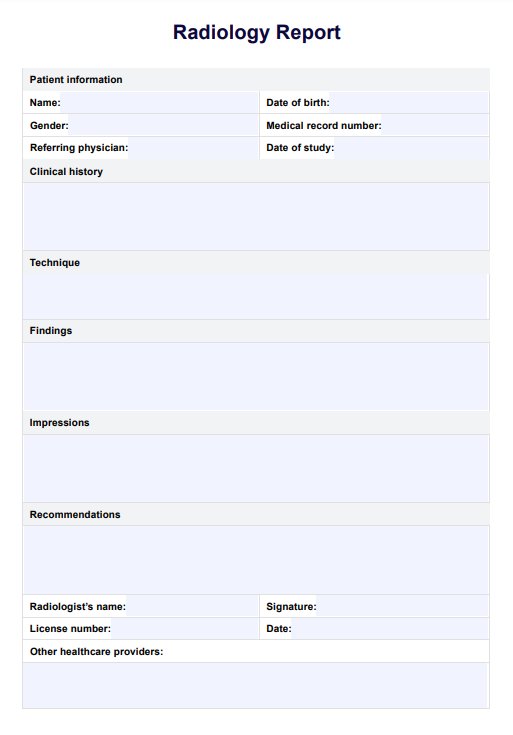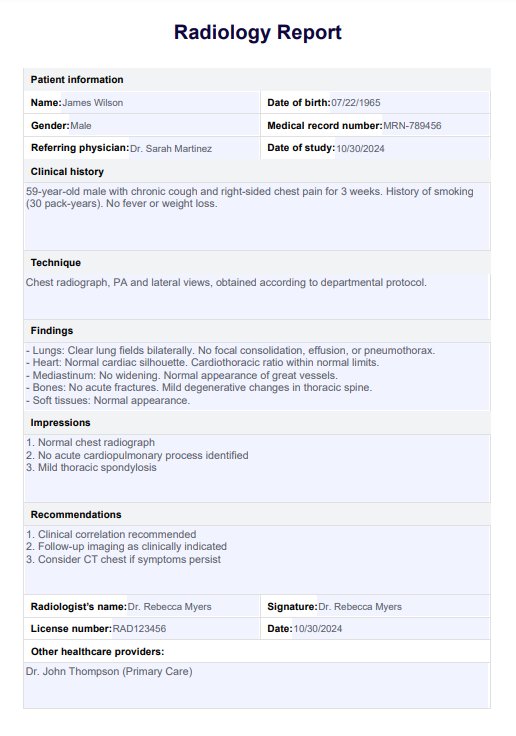
Get a free Radiology Report Template for easy clinical documentation. Download the PDF and example here.

By Ericka Pingol on Jul 15, 2024.


A radiology or medical imaging test is a diagnostic procedure to visualize the body's internal structures. This includes using X-rays, ultrasound, MRI, CT scans, and nuclear medicine, including bones, organs, and tissues.
Physicians commonly order radiology tests to help diagnose and monitor various medical conditions. These tests can help identify abnormalities, assess the extent of injuries or diseases, and guide treatment options. Some common types of radiology tests include:


A radiology report is a crucial document that conveys the findings of a radiology test to referring physicians. It represents the radiologist's expert interpretation of the imaging study, providing valuable information for diagnosis, treatment planning, and follow-up care.
The accuracy and clarity of these reports play a vital role in clinical decision-making, as they are integral to the continuum of patient care and improved patient outcomes. They offer a comprehensive review of the patient's condition and help assess the progression or resolution of a condition over time.
According to the Radiological Society of North America (n.d.), these structured reports serve as an "essential conduit for radiologists to convey their diagnostic input." Consistent, standardized reporting templates reduce confusion and enhance communication among healthcare professionals.
A radiology report should include essential elements such as (American College of Radiology, n.d.):
Referring physicians, radiologists, and other healthcare professionals can utilize our free Radiology Report Template to create comprehensive and standardized reports for their patients quickly. Here's how to get started:
Get a copy of the structured report template using the link on this page. You may also get it from the Carepatron app or our resources library.
You can use the digital version of our template, which can be filled out electronically. Alternatively, print a paper copy and fill it in by hand.
To complete the report, enter all necessary patient data, including any relevant history and laboratory findings. Use the designated sections to describe imaging techniques and findings.
Before submitting the report, review and verify all information for accuracy. Structured reporting drastically reduces the chances of mistakes, but it's always important to double-check.
Once you have completed all sections and validated the information, submit the report to the appropriate parties involved in patient care. This may include referring physicians or other specialists needing to review the findings.
Here are several benefits of using Carepatron's free Radiology Report Template:
You can complete the report electronically, saving time and avoiding the hassle of printing and scanning. It also makes submitting the results to the referring physician quicker and easier.
Our template is designed to be easy to use, with clearly labeled sections for necessary information. You can also modify the template to fit your specific reporting needs. You can add information like a consensus statement, critical findings, or additional images.
A standardized format for radiology reports ensures all necessary information is included and organized logically. This makes it easier for other healthcare professionals to understand and interpret the results.
Using our Radiology Report Template can significantly reduce the risk of errors or omissions in the report. Medical practices with a standardized reporting process typically have fewer mistakes and more accurate results.